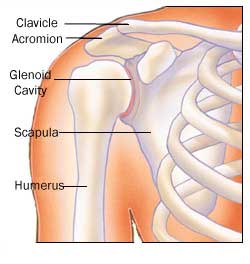Rotator cuff tear
(Redirected from Rotator cuff tears)
A rotator cuff tear is a common injury involving the shoulder's rotator cuff muscles or tendons. The rotator cuff is a group of four muscles and their associated tendons that stabilize the shoulder and allow for its wide range of motion.
Anatomy[edit | edit source]
The rotator cuff consists of the supraspinatus, infraspinatus, teres minor, and subscapularis muscles. These muscles originate from the scapula and attach to the humerus, forming a cuff around the shoulder joint.
Types[edit | edit source]
Rotator cuff tears can be classified into two main types:
- Partial tear: This type of tear damages the soft tissue but does not completely sever it.
- Full-thickness tear: This type of tear is more severe and involves a complete rupture of the tendon.
Causes[edit | edit source]
Rotator cuff tears can result from:
- Acute injury: Sudden trauma, such as falling on an outstretched arm.
- Chronic overuse: Repetitive overhead activities, common in sports like baseball and tennis, or occupations such as painting and carpentry.
Risk Factors[edit | edit source]
Several factors can increase the risk of developing a rotator cuff tear:
- Age: The risk increases with age due to wear and tear.
- Repetitive overhead activities: Sports and jobs that involve frequent overhead motions.
- Trauma: Direct injury to the shoulder.
Symptoms[edit | edit source]
Common symptoms of a rotator cuff tear include:
- Shoulder pain, especially at night
- Weakness in the shoulder
- Limited range of motion
Diagnosis[edit | edit source]
Diagnosis typically involves:
- Physical examination: Assessing pain, range of motion, and strength.
- Imaging studies: X-rays, ultrasound, or MRI to visualize the tear.
Differential Diagnosis[edit | edit source]
Conditions that may present similarly include:
Treatment[edit | edit source]
Treatment options vary based on the severity of the tear:
- Non-surgical: Physical therapy, medications such as NSAIDs, and corticosteroid injections.
- Surgical: Arthroscopic surgery or open repair for severe cases.
Prevention[edit | edit source]
Preventive measures include:
- Strengthening exercises: Focused on the rotator cuff and shoulder muscles.
- Proper technique: In sports and occupational activities to avoid overuse injuries.
Complications[edit | edit source]
Potential complications from a rotator cuff tear include:
- Frozen shoulder (adhesive capsulitis)
- Arthritis in the shoulder joint
See Also[edit | edit source]
References[edit | edit source]
Translate: - East Asian
中文,
日本,
한국어,
South Asian
हिन्दी,
தமிழ்,
తెలుగు,
Urdu,
ಕನ್ನಡ,
Southeast Asian
Indonesian,
Vietnamese,
Thai,
မြန်မာဘာသာ,
বাংলা
European
español,
Deutsch,
français,
Greek,
português do Brasil,
polski,
română,
русский,
Nederlands,
norsk,
svenska,
suomi,
Italian
Middle Eastern & African
عربى,
Turkish,
Persian,
Hebrew,
Afrikaans,
isiZulu,
Kiswahili,
Other
Bulgarian,
Hungarian,
Czech,
Swedish,
മലയാളം,
मराठी,
ਪੰਜਾਬੀ,
ગુજરાતી,
Portuguese,
Ukrainian
Navigation: Wellness - Encyclopedia - Health topics - Disease Index - Drugs - World Directory - Gray's Anatomy - Keto diet - Recipes
Search WikiMD
Ad.Tired of being Overweight? Try W8MD's physician weight loss program.
Semaglutide (Ozempic / Wegovy and Tirzepatide (Mounjaro / Zepbound) available.
Advertise on WikiMD
WikiMD is not a substitute for professional medical advice. See full disclaimer.
Credits:Most images are courtesy of Wikimedia commons, and templates Wikipedia, licensed under CC BY SA or similar.Contributors: Prab R. Tumpati, MD





